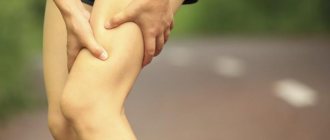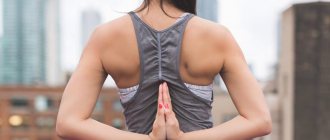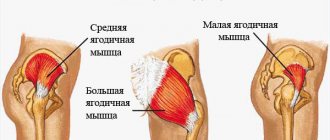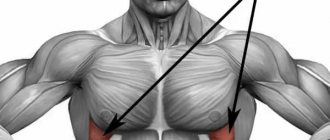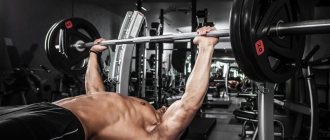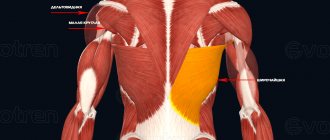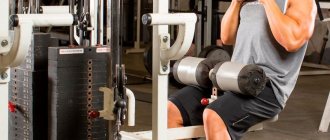Rhomboid major and minor muscles[edit | edit code]
Rhomboid major and minor muscles
Home[edit | edit code]
- Rhomboid minor muscle: spinous processes of cervical vertebrae C6-C7
- Rhomboid major muscle: spinous processes of thoracic vertebrae T1-T5
Attachment[edit | edit code]
- Rhomboid minor: medial edge of the scapula near the spine, superior to the triangle of the spine
- Rhomboid major: medial border of the scapula between the spine of the scapula and the inferior angle, inferior to the triangle of the spine
Innervation[edit | edit code]
- Dorsal scapular nerve, C4-C5
Diagnosis of disorders in the rhomboid muscle
Problems with the rhomboid muscle can be identified by pain that occurs in the shoulder blade area. The pain does not depend on the intensity of movement and can be felt by the patient even during rest, when the person is in a horizontal position. Painful sensations do not have a clear localization specifically in the rhomboid muscle - they are also felt in the muscles that compensate for the work of weakened muscle tissue. And as is already known, these muscles are the tissues of the lumbar back. That’s why if a patient feels pain not only between the shoulder blades, but also in the lower back, experts do not rule out that the source of pain is the rhomboid muscle. To be sure of this, the patient must undergo appropriate examination to make an accurate diagnosis.
Participation in sports[edit | edit code]
The rhomboids bring the arm down from an elevated position, a movement important in kayaking, breaststroke, or the swing motion of tennis, badminton, volleyball, and handball. The same function is necessary when extending the upper limb from the starting position, for example, in cross-country skiing and crawl swimming. Scapular adduction is important in diving and discus throwing. These muscles also provide an optimal position for contraction during shoulder adduction (gymnastics) and extension (cross-country skiing). In addition, these muscles stabilize the shoulder girdle and are required in various sports, especially archery and gymnastics.
| Kind of sport | Movement/hold | Function | Load | Types of abbreviations |
| Kayaking | Pickup and transfer phases | Internal rotation of the scapula | Strength endurance | Dynamic concentric |
| Tennis, badminton, volleyball and handball | Return of the arm during swing movements | Internal rotation of the scapula | Fast, explosive, strength endurance | Dynamic concentric |
| Swimming | Swimming crawl, pull-up and push-off phases | Internal rotation of the scapula | Strength endurance | Dynamic concentric |
| Discus throw | Hand return | Scapular adduction | Fast | Dynamic concentric |
| Gymnastics | Return of the arm during various gymnastic elements | Scapular adduction | Fast, explosive | Dynamic concentric |
| Holding the torso, for example, during a handstand | Shoulder girdle stabilization in the mediolateral direction | Strength endurance | Static |
How to pump up the rhomboid muscle
Many bodybuilders do not pay enough attention to this group, preferring to pump up larger muscle groups - the latissimus and trapezius. Undoubtedly, after the necessary elaboration, they look much more impressive due to their large size and surface location. However, professional athletes strongly recommend not to lose sight of such a seemingly minor group as the rhomboid back muscle. Without this, it is impossible to achieve a truly beautiful and full dorsal relief, or to obtain the desired volume of its upper part. This is especially true for athletes taking part in competitions and competitions.
This is no less important for people who are not involved in professional bodybuilding or fitness, but who care about the beauty of their figure. Regular training of the rhomboid muscle allows you to maintain a straight posture and prevent the premature development of pathological age-related changes in the spine. These exercises are especially important for people engaged in sedentary work. With forced daily immobility for many hours, the muscle groups of the back lose their tone. The result of this is stooping, drooping shoulders, pain in the back and cervical region.
The main function of the rhomboid muscle is to fix and reduce the shoulder blades. Therefore, for its high-quality pumping, you should perform a set of general exercises on the back, with the addition of several highly specialized movements. This will allow you to focus on working on this particular group. It will also prevent them from falling behind in development from the neighboring trapezius and latissimus muscles.
The main difficulty with fixed stimulation of the rhomboid back muscle, whose functions are limited, is the inability to load this particular area in isolation. All exercises, with varying degrees of intensity, will involve the trapezius and, in part, the shoulder and lat groups. Therefore, for accentuated pumping, experienced instructors recommend:
- Perform all exercises on the rhomboid muscle at a slow pace, without jerking or acceleration. This way the load will be best transferred to the desired areas, without connecting neighboring groups.
- Work with light loads, but with a large number of repetitions in one approach.
- Master the technique of focusing the load, with minimal involvement of neighboring muscle nodes.
By following these recommendations, the effect of training increases significantly. And for high-quality work you will need to spend much less time and effort. One important advantage is that rhomboid back exercises can be done at home. They do not require special equipment, and for effective work you can get by with a horizontal bar and dumbbells.
Read also[edit | edit code]
- Muscles - anatomy and functions
- Muscles of the shoulder girdle
- Arm muscles
- Shoulders - exercises and training features
- Anatomy of the shoulder joint
- Trapezius muscle
- Levator scapulae muscle
- Serratus anterior muscle
- Deltoid
- Supraspinatus muscle
- Infraspinatus muscle
- Subscapularis muscle
- Latissimus dorsi muscle
- Teres major muscle
- Teres minor muscle
- Pectoralis major muscle
- Pectoralis minor muscle
- Subclavius muscle
- Coracobrachialis muscle
The superficial muscles of the back, starting on the bones of the axial skeleton, are attached to the bones of the belt and free upper limb. These include the trapezius (m. trapezius) and latissimus dorsi (m. latissimus dorsi). The first of them starts from the upper nuchal line and ligament, the spinous processes of the thoracic vertebrae, and is attached to the scapula and collarbone. The muscle raises and lowers the scapula and brings it to the spinal column. The latissimus dorsi muscle originates from the sacrum, ilium, spinous processes of the lumbar and 6 lower thoracic vertebrae and is attached to the humerus: it adducts, extends and rotates the upper limb medially.
In the middle layer of the back muscles lie the rhomboid major and minor (mm. rhomboidei major et minor), the upper and lower posterior serratus muscles (mm. serratus posterior superior et inferior), as well as the levator scapulae muscle (m. levator scapulae). The rhomboid muscles originate from the spinous processes of the last cervical and five upper thoracic vertebrae and are attached to the medial edge of the scapula along with the levator scapulae muscle. These muscles move the scapula upward and closer to the spine. The serratus superior muscle spreads from the spinous processes C6-7 - Th1-2 to the four upper ribs, the serratus inferior muscle - from the spinous processes Th11-12 - L1-2 to the four lower ribs. The serratus superior raises the ribs, the serratus inferior lowers them. Deep back muscles provide movement and balance
torso and head. They are part of the “muscle corset”, which ensures the stability of the spinal column and the correct position of the internal organs. The muscles form two isolated tracts. The lateral tract is represented by the erector spinae muscle, which combines the longissimus muscle, the iliocostalis muscle and the spinalis muscle. The medial tract includes the transverse spinalis muscle (m. transversospinalis), the bundles of which spread across a different number of vertebrae and form the semispinalis muscle (m. semispinalis), 5-7 vertebrae; multifidi muscles (mm. multifidi), 2-4 vertebrae; and rotator muscles (mm. rotatores), 1 vertebra.
Raising the arm above the horizontal level , elevatio, is accomplished with the participation of the muscles of the trunk and the girdle of the upper limb. In this case, the upper bundles of the trapezius muscle pull the lateral angle of the scapula upward and medially, the lower bundles - downward and medially. The serratus anterior muscle moves the inferior angle of the scapula downward and laterally. The combined action of these muscles rotates the scapula around the sagittal axis passing through its upper angle. As a result, the glenoid cavity of the scapula rises upward, and with it the humerus, held in a horizontal position by the contraction of the deltoid and supraspinatus muscles.
Physical exercises in the gym to strengthen the rhomboid muscle
- Movement of the block from the floor to the lower back from a sitting position. This exercise helps to significantly strengthen all back muscles as a whole. Sit on the simulator and take the handle of the projectile in your hands, while resting your feet on the special racks. In this position, the knees are bent and the body is vertical to the floor. The position of the lower back becomes similar to a deflection. Now you need to take a deep breath, and as you exhale, pull the handle of the exercise machine towards you all the way to your lower abdomen and return your body to a vertical position. For the greatest effect, it is necessary to bring the shoulder blades as close as possible to each other during the exercise.
- Movement of the block to the chest. This exercise is analogous to pull-ups on a horizontal bar, which allows you to make maximum use of the rhomboid back muscle. To perform this exercise, take the handle of the machine and sit on a special seat. Then, as you exhale, pull the block towards you to the point of the upper part of the sternum, slightly tilting your body back. As you inhale, you need to return to the starting point. While pulling the projectile towards you, move your chest towards the handle, and bring your shoulders behind you as much as possible.
- Pull-ups on the horizontal bar involve many back muscles, which is very effective for strengthening the rhomboid muscle, which is involved along with the rest. To perform this exercise, you need to grab the bar so that your hands are much wider than the ends of the shoulder part of the body. Next, you need to pull yourself up, trying to get your chest to touch the bar of the horizontal bar. Having achieved your goal, you need to return to the starting point. When pulling up, your back should arch slightly and your head should look up.
- The bent over movement with a dumbbell is good for strengthening the central and upper torso. To perform this exercise, you need to place your left kneecap on a bench or any support, and then rest your hand there, with your torso positioned almost parallel to the floor. In this pose, a deflection of the lumbar back is formed, and the right leg stands on the floor. Next, with your right hand, as you exhale, pull the projectile to the lower abdomen, and while inhaling, return to the starting point. For greater effect, you should try to perform the exercise using your back muscles, not your arms.
- The movement of the block to the stomach occurs on the simulator from a sitting position. The load is pulled as you exhale. At this moment, you need to straighten your chest and point your elbows back. As you inhale, we return to the starting point. The main thing with this exercise is that the movements are smooth, without sudden lunges.
- Exercise with a barbell. You need to grab the barbell with your hands, wider than your shoulders, and lean forward slightly with your legs bent. As you inhale, reach the barbell to your lower abdomen, and as you exhale, return to the original position.
Some exercises can be performed in the gym, and it is better to do them under the supervision of a trainer who will prevent incorrect movements
For athletes who train muscles professionally, for example, bodybuilders, it is necessary to devote as much time as possible to stretching exercises for the back muscles in order not to overload them, as well as to prevent problems with the rhomboid muscles, since such people are most susceptible to such pathologies.
Links[edit]
- ^ a b
Platzer 2004, p. 144 - ^ a b
"Musculature of the shoulder girdle". Hosford muscle tables. 1998. Archived from the original on October 22, 1999. Retrieved January 2011. Check date values in: |access-date=(help) - Brand 2008, pp. 538-41
- Brand, R. A. (2008). "Origin and comparative anatomy of the thoracic limb". Clinical Orthopedics and Related Research
.
466
(3):531–42. DOI: 10.1007/s11999-007-0102-6. PMC 2505211. PMID 18264841. - Platzer, Werner (2004). Color Atlas of Human Anatomy, Vol.
1: Musculoskeletal system (5th ed.). Time. ISBN 3-13-533305-1.
Clinical significance[edit]
If the rhomboid major is torn, worn out, or cannot contract, it can cause scapular instability. Consequences of scapular instability caused by the rhomboid major include winging of the scapula during scapular extension, excessive lateral rotation, and scapular depression because the antagonistic action of the rhomboid major is absent. With scapular instability, movement in the upper extremity is limited because the scapula cannot direct the desired movement of the arm and shoulders. Pain, discomfort, and limited range of motion in the shoulder are possible consequences of scapular instability.
Treatment for scapular instability may include surgery followed by physical or occupational therapy. Physical therapy may consist of shoulder stretching and endurance exercises. Pilates and yoga have also been suggested as potential treatments and prevention for scapular instability.
Other animals[edit]
The shoulder muscles can be divided into three topographic units: the scapulohumeral, axiohumeral and axioscapular groups. Extending from the spine to the scapula, the rhomboid major forms part of the latter group along with the rhomboid minor, serratus anterior, levator scapulae, and trapezius. The trapezius evolved separately, but other muscles in this group are derived from the first eight or ten ribs and the transverse processes of the cervical vertebrae (homologous to the ribs). Functional demands led to the development of individual muscles from the basal unit formed by the serratus anterior.
In primitive forms of life, the main function of the axioscapular group is to control the movements of the vertebral edge of the scapula: fibers associated with dorsal movement of the scapula became rhomboid, fibers with ventral movement became serratus anterior, and fibers with cranial movement. movements in the levator scapulae. [3]
